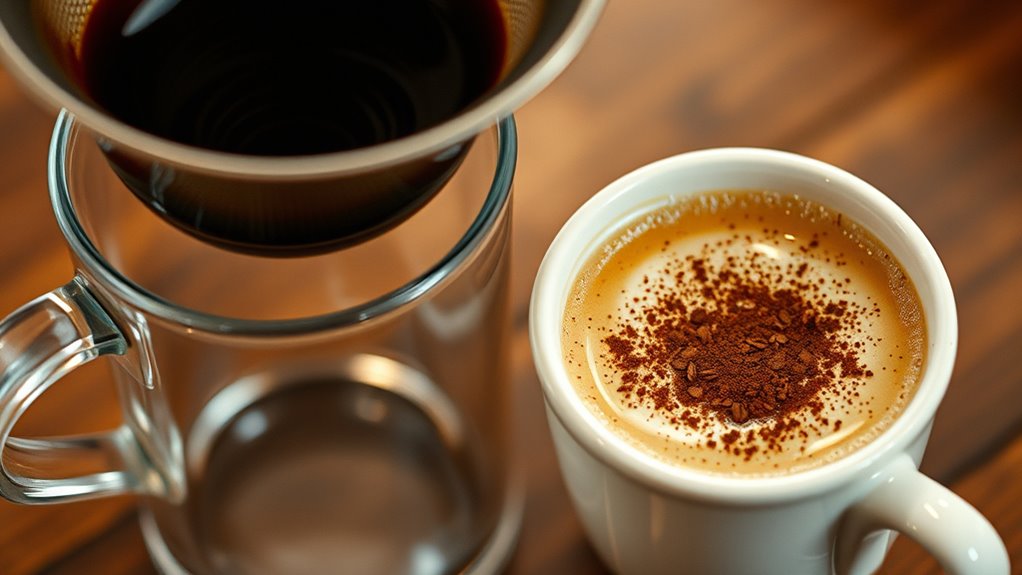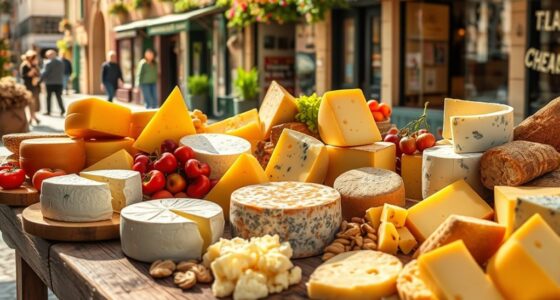Immerse yourself in Vietnam’s vibrant coffee culture, where traditional brewing methods like the iconic phin filter highlight patience and craftsmanship. From simple drip coffee to the sweet, icy cà phê sữa đá, each drink reflects social customs and community spirit. Egg coffee adds a touch of ingenuity with its frothy, rich texture. Exploring these techniques reveals how Vietnamese coffee embodies centuries of tradition and innovation—continue on to discover even more about this enthralling coffee journey.
Key Takeaways
- Vietnamese coffee culture emphasizes patience, craftsmanship, and community, reflected through traditional brewing methods like the phin filter.
- Drip coffee is simple and popular, showcasing the slow, deliberate process valued in Vietnamese traditions.
- Egg coffee exemplifies ingenuity, combining whipped egg yolks with condensed milk for a rich, indulgent beverage.
- Cafe etiquette involves polite interactions, respecting unhurried service, and sharing coffee as a social act.
- Observing and participating in coffee brewing enhances appreciation of Vietnam’s deep cultural and social heritage.

Vietnamese coffee culture is a vibrant and integral part of daily life in Vietnam, where coffee shops serve as social hubs and gathering places. When you step into a local cafe, you quickly notice the importance placed on coffee brewing techniques and cafe etiquette. These elements aren’t just about making a good cup; they embody a way of life rooted in patience, respect, and community. As you settle in, you’ll see baristas meticulously prepare coffee using traditional methods, such as the iconic phin filter. This small metal device is central to Vietnamese coffee brewing, allowing you to enjoy a slow, flavorful extraction that’s rich and smooth. The process often takes a few minutes, giving you time to relax and observe the surroundings.
In Vietnam, cafe etiquette is subtly observed and deeply respected. When you order, it’s customary to greet the staff politely and perhaps engage in small talk before settling in. Paying attention to local customs shows appreciation for the culture. For example, if you’re sitting with friends or locals, it’s polite to pour coffee for others and wait your turn to be served. Many cafes operate on a relaxed, unhurried pace, encouraging you to linger over your drink and enjoy the moment. It’s common to see people sipping their coffee slowly, sometimes adding condensed milk or sugar, depending on their preference. If you’re unsure about how to order or what to ask for, simply observe others or ask the staff; they’re usually friendly and enthusiastic to help.
Vietnamese coffee isn’t just about the taste but also about the experience. Whether you’re enjoying a simple drip coffee, a sweetened iced cà phê sữa đá, or the unique egg coffee, each method of brewing carries its own cultural story. The egg coffee, for instance, involves whipping egg yolks with sugar and sweetened condensed milk to create a frothy, indulgent drink served hot or cold. This preparation showcases the ingenuity of Vietnamese baristas and their mastery of coffee brewing. As you savor each sip, you’re partaking in a tradition that values patience, craftsmanship, and community. Observing the brewing process and the cultural significance behind each method enhances appreciation for the rich tradition. The relaxed yet respectful cafe etiquette adds to the charm, making every coffee break in Vietnam a moment to appreciate not just the beverage but also the culture behind it.
Frequently Asked Questions
How Did Vietnamese Coffee Culture Originate Historically?
You might not know, but Vietnamese coffee culture originates from colonial influence, especially during French rule. The French introduced coffee plants and brewing techniques, which blended with local traditions, creating a unique coffee scene. This colonial legacy shaped how you enjoy coffee today, from drip brews to the famous egg coffee. Over time, Vietnam’s coffee culture evolved, reflecting both its history and local preferences, making it truly distinctive.
What Are the Health Benefits of Traditional Vietnamese Coffee?
You’ll enjoy several health benefits from traditional Vietnamese coffee, like its antioxidant properties that help fight free radicals and support your overall health. Plus, the caffeine boosts your mental alertness, keeping you focused and energized throughout the day. Drinking it in moderation can enhance your mood and cognitive function, making it a delicious way to stay sharp while enjoying rich, flavorful coffee.
How Has Vietnamese Coffee Influenced Global Coffee Trends?
You might think Vietnamese coffee has limited global impact, but its coffee innovation has profoundly shaped worldwide trends. The rich flavors, unique brewing methods like drip and egg coffee, and bold presentation inspire baristas and coffee brands globally. This influence fuels coffee innovation, encouraging experimentation and diverse styles. As a result, Vietnamese coffee’s cultural richness and creative techniques continue to leave a lasting global influence, transforming the way people enjoy coffee worldwide.
What Are Common Regional Variations in Vietnamese Coffee?
You’ll notice regional brewing methods shape Vietnamese coffee’s diverse flavor profiles. In the Central Highlands, robusta beans dominate, creating stronger, more bitter brews. In the southern regions, sweeter, milk-based drinks like cà phê sữa đá are popular, highlighting a creamier flavor. Northern Vietnam favors drip brewing with lighter roasts, offering a milder taste. These regional variations reflect local tastes and traditions, giving Vietnamese coffee its rich, varied character.
How Do Vietnamese Coffee Customs Differ Between Urban and Rural Areas?
In urban areas, you’ll find fast-paced coffee customs like quick drip brews at bustling cafes, emphasizing socializing and convenience. In rural regions, traditional rural customs shine through, with locals often brewing coffee at home using simple methods and savoring it slowly. Urban traditions focus on modernity and efficiency, while rural customs celebrate community and time-honored practices. You’ll notice these differences in how people enjoy and approach their daily coffee routines.
Conclusion
As you explore Vietnamese coffee, you discover a world richer than a mountain of beans—each sip bursting with history, passion, and artistry. From the slow drip of traditional filters to the sweet, velvety egg coffee, you experience a culture that turns everyday moments into unforgettable rituals. So next time you take a sip, remember, you’re tasting centuries of craftsmanship that could fill an ocean of stories—truly a coffee lover’s paradise beyond your wildest dreams.








